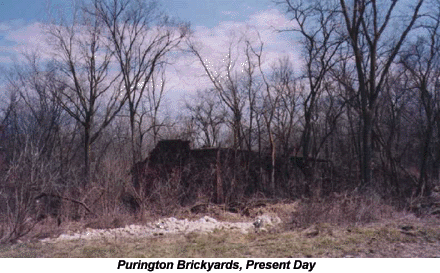
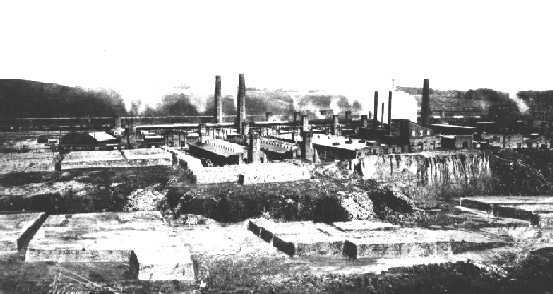




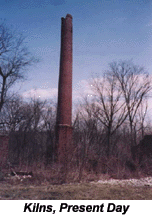 At one time, there were numerous brickyards in Knox
County. Most produced a "soft" brick, used in the
construction of buildings, but the Purington Paving
Brick Company in East Galesburg manufactured heavy,
solid "paving" bricks used all over the United States.
It was once the largest brick-maker in the world.
At one time, there were numerous brickyards in Knox
County. Most produced a "soft" brick, used in the
construction of buildings, but the Purington Paving
Brick Company in East Galesburg manufactured heavy,
solid "paving" bricks used all over the United States.
It was once the largest brick-maker in the world.Although no longer in business, the old brickyards, located just north of milepost 51 on Interstate 74, remain. Overgrown with weeds and brush, the crumbling buildings and kilns can be still be seen. Birds and wildlife have taken over the land where over 800 workers once used the blue shale and yellow soil to produced over 150,000 bricks a day.
The first brick was manufactured in the area in 1849. Henry Grosscup, a German stone mason, purchased 90 acres of land from Knox College trustees. The college was paid for the land in brick, which was used to construct Whiting Hall and Old Main.
| The largest order ever filled was at the start of World War II when Dupont Co. ordered 22,000,000 building bricks for a munition plant being constructed in southern Indiana. The company worked at full production for 146 days to fill the order. Seven or eight freight cars were filled each day with brick that was shipped at night. The next morning, the bricks arrived at the building site, still warm from the kiln. | 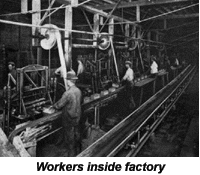 |
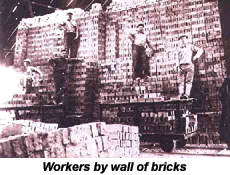 The process of making the bricks was labor intensive.
The shale was scooped out of nearby pits. Mixed,
crushed, dampened and molded, the raw brick had a green
color. It was set by hand onto large, movable platforms.
Old timers recall the physical labor involved as a
green brick pitcher tossed the clay bricks, sometimes
two and three in each hand, to the catcher above, who
stacked them in the kiln. The catcher often used old
leather shoe soles, cut individually for each hand, to
help curb the blisters. Teen-age boys were hired as
"sand monkeys"-workers who threw sand on the bricks so
they wouldn't stick together in the kiln. Many
long-time employees started out their careers that way.
The process of making the bricks was labor intensive.
The shale was scooped out of nearby pits. Mixed,
crushed, dampened and molded, the raw brick had a green
color. It was set by hand onto large, movable platforms.
Old timers recall the physical labor involved as a
green brick pitcher tossed the clay bricks, sometimes
two and three in each hand, to the catcher above, who
stacked them in the kiln. The catcher often used old
leather shoe soles, cut individually for each hand, to
help curb the blisters. Teen-age boys were hired as
"sand monkeys"-workers who threw sand on the bricks so
they wouldn't stick together in the kiln. Many
long-time employees started out their careers that way.
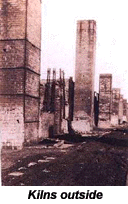 The bricks were fired in the kiln and shrunk one inch
in eight inches when burned to the point of
vitrification. The kilns had to be cooled and cleaned
between firing.
The bricks were fired in the kiln and shrunk one inch
in eight inches when burned to the point of
vitrification. The kilns had to be cooled and cleaned
between firing.
By 1948 paving bricks were no longer in demand, so the company switched over to producing the 2x4x8 inch facing bricks used for buildings. In 1952 the equipment was updated and "continuous" kilns were put in. The gas-fired drying and baking replaced the coal fires and cooling down the kilns was no longer necessary. Production went up and air pollution went down.
The brickyard officially closed in 1974. The Alton Brick Company, which is owned by Marge Schott, who also owns the Cincinnati Reds baseball team, owns the ground. The brickyards are silent, but for many old-timers, the memories remain.
